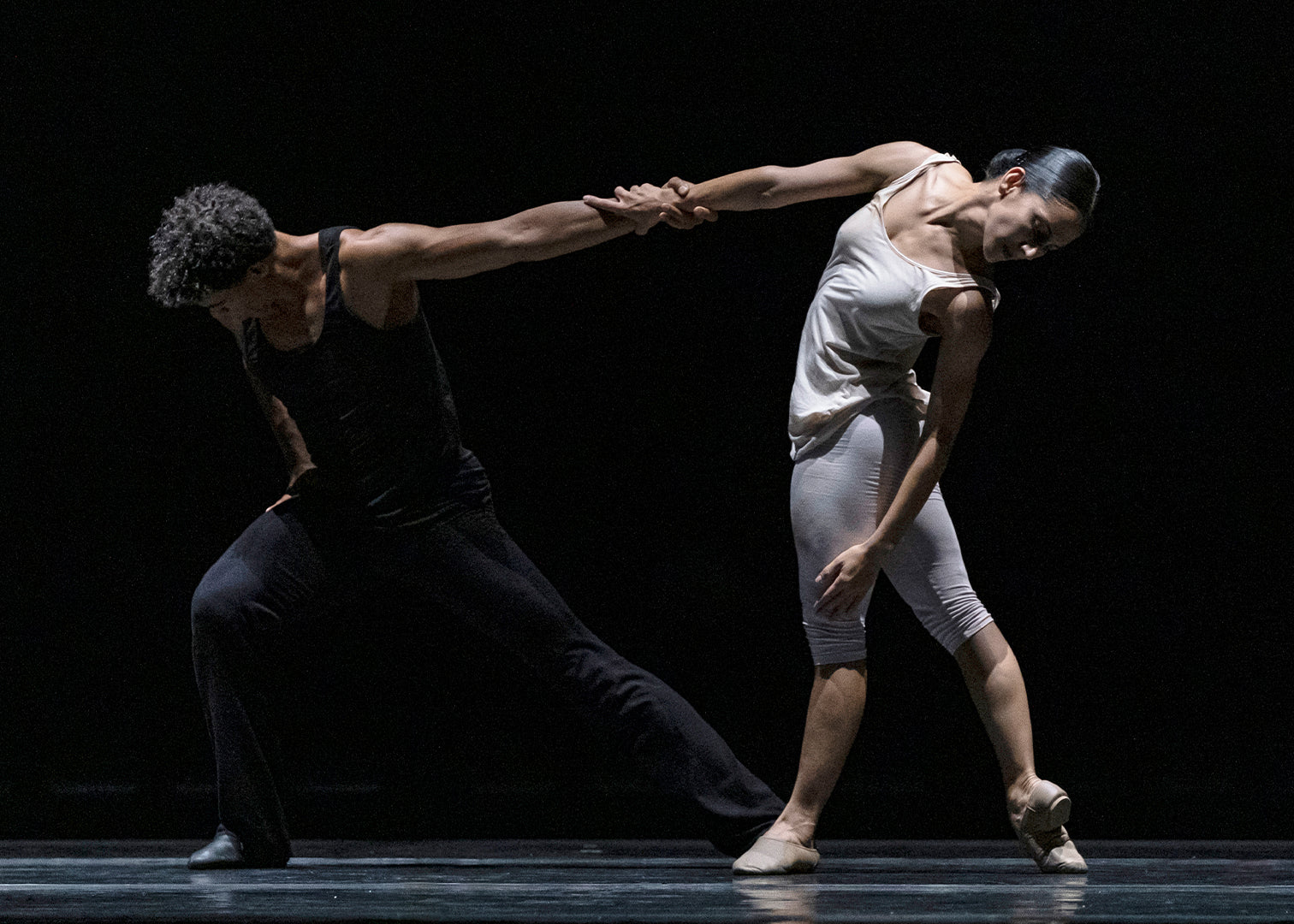Described by the choreographer as a “queer love power trio,” the world premiere opus, “New Faithful Disco,” featured an electrifying Taisha Paggett (think Grace Jones!), Marbles Jumbo Radio (Rae Shao-Lan in an earlier incarnation), and a cool, kittenish Wolfe. Making use of the bygone disco days of the 70’s as a framing device for this fifty-minute journey into love, loss and, well, bell-bottoms, the dancemaker also created tableaux smacking of Saturday Night Fever, The Deer Hunter and a pre-AIDS world, sans, however the requisite amyl nitrate “poppers”—but with literal nods to the heart-wrenching AIDS quilt, also seen here at times as three distinct—but un-monogrammed—comforters/cum/robes (designed by Wolfe).
Talk about a security blanket!
Frequent Wolfe collaborator, Maria de los Angeles “Cuca” Esteves, created the provocative soundscape, a decided mash-up of Studio 54/Plato’s Retreat-era tunes with an industrial, electro-thrumming (choppers over Vietnam?), punctuated by an occasional cricket chirrup. The work opened with the perky refrains of Anita Ward’s “Ring My Bell,” as the dancers sluggishly crawled to a large quilt.
And while the score was a tad manipulative (thankfully, without Arvo Pärt’s beloved, but overly exposed, “Spiegel im Spiegel,” which probably would be hip sampled and remixed), the sonic collage, instead, served as a Sherpa-like guide to the dancers’ preenings, prancings and pirouettings.
One-legged balancing poses, über-arched backs and unison arm-swinging may not have recalled John Travolta’s Tony Manero—nor were there any white suits—but the notion of using one’s body to find love in all the wrong places throbbed here with its own kind of heat: Garbed in Gregory Barnett’s costumes, Wolfe, in flowy satin skirt and blouse, her bare white legs a kind of beacon of vulnerability, held her own against Radio, who sported a vest and flared pants while deploying Rockette-style kicks.
Paggett, a knockout in a midriff-baring top (she comes from the “where-is-my-stomach” school of dance), and golden-colored, belled pants, wanting in on the action, her own lunges, sturdy and sinewy, hooked up with Wolfe, the latter soon breaking away for a solo, dipping and turning to an ostinato bass that cranked up to fortississimo.
Anonymous connections were forged and broken, with the isolation theme (voluntary or self-imposed), certainly less joyful in these post-disco days, the essential overhead rotating glitter ball noticeable in its absence. Yes, back in the day, this sparkling symbol of boundless freedom was both literal and metaphorical in refracting and fracturing relationships, often in the space of one song.
Alas, Donna Summer is dead, Gloria Gaynor did not warble “I Will Survive,” and Oscar-winning Giorgio Moroder is now scoring episodic television, including music for The Simpsons and Parks and Recreation. One wonders if Wolfe thought that the shiny sphere would have been too cliché, or did she merely decide fun was not the point, several moments of levity, whether intended or not, aside.
Yes, the donning of gold-hued antler bonnets initially had a startling, albeit amusing effect, unlike, say, that of the Yaqui Deer Dance, a virtuosic staple trotted out in every Ballet Folklórico de México concert. Still, other images were conjured in this “Dances With Antlers”: the gals became valkyries, powerful daughters of Odin, the god of war, ready to take on the world, or at least execute full cobra positions prone on the floor, their antlers precariously held in place by dint of chin straps.
Seriously, the visuals were somewhat surreal (no red-nosed Rudolphs here), but as a triumvirate, again standing, arms raised, faces blank or striking a pose Madonna-style, these performers were fierce in their determination and precise in their execution of steps, especially when arching and pointing articulated feet.
The antler trope also proved a foray into empowerment (were those guns being fired as part of the score?), a take-no-prisoners approach both enigmatic and consoling. Then, as if in the court of Louis XIV, these neo-mythological be-antlered creatures were bowing to each other in minuet mode one moment, locking horns, so to speak, in the next, though more in peace, than in struggle.
Such fleeting junctures served as tiny time capsules, the women ultimately flipping their quilts, revealing sumptuous robes, as they walked, pavane-like, brandishing these royal garments oh so veddy veddy nobly, but still proceeding with their antler headdresses precariously perched atop their heads à la Vegas showgirls.
A vacillation between abandon and control was also in evidence, as it is much of the time in the twenty-first century, where our destinies seem to lie in our Instagram, Facebook and Periscope handles: anonymous or apparent; free or feral; loving or loathsome. Who are these women? Who are we? More importantly, where can this reviewer get a pair of those antlers?
Not here, not now, as the horns disappeared, with disco queen Gaynor oozing through the charged air, wisps of her hit, “Never Can Say Goodbye” prelude to Wolfe’s lovely trance dancing—with antlers —a move not unfamiliar to this serious sprite. Indeed, to this reviewer, Wolfe looked as if she might have studied with Banafsheh Sayyad, master of contemporary sacred dance and spiritual spinner of the highest order.
But back to the pseudo-nightclub that was the black box of REDCAT, where Ellie Rabinowitz’ lighting design was not exactly disco ready, i.e., assaultive with strobes, but effectively cast the occasional red and blue tone, also bathing the dancers in pockets of warm glow. Gaynor’s voice, now smashed between the tweets of birds and gentle sounds of falling rain, finally gave way to the yips and yaps of a barking dog.
The trio ended the work where it began, on the floor. Wolfe is clever and committed, her interpretation of the past more than a lingering moment in the present, struck through, as it is, with elements of grace, grit and puckish charm.
Let’s just say that Wolfe can ring my bell anytime.









comments